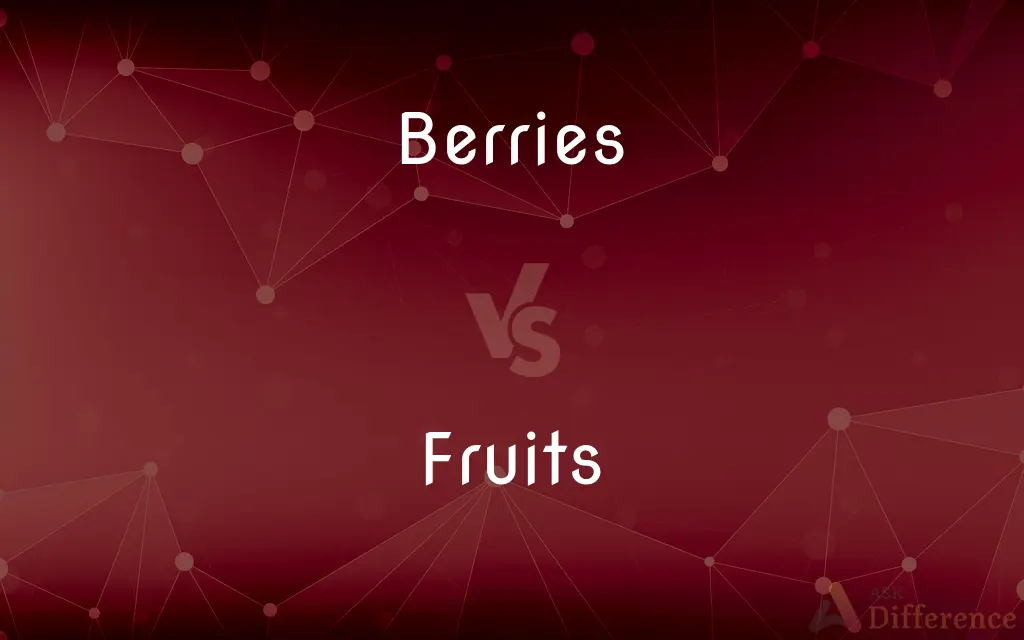Berries vs. Fruits — What's the Difference?
By Tayyaba Rehman — Published on January 14, 2024
Berries are a specific type of fruit with seeds enclosed in fleshy pulp, while fruits are a broader category including all seed-bearing structures of flowering plants.

Difference Between Berries and Fruits
Table of Contents
ADVERTISEMENT
Key Differences
Berries are a specific type of fruit characterized by their whole ovary wall turning into a fleshy pulp enclosing the seeds. Fruits, in general, encompass a broader range of seed-bearing structures developed from the ovary of a flowering plant, which includes berries, but also types like drupes, pomes, and citrus fruits.
The definition of berries in botanical terms is quite specific and includes fruits like grapes, tomatoes, and cucumbers, which are often not thought of as berries. In contrast, the general term 'fruit' covers a wide range of plant products, from apples and oranges to nuts and grains.
Common fruits often mistaken for berries, like strawberries and raspberries, are not true berries botanically. True berries have seeds inside the fleshy part of the fruit, while in fruits like strawberries, the seeds are on the outside.
In culinary contexts, the distinction blurs, and many fruits are commonly referred to as berries due to their size, taste, and texture, rather than their botanical classification. Meanwhile, all kinds of sweet, edible plant parts, including berries, are categorized as fruits in cooking.
Berries are typically small, juicy, and have a relatively thin skin, whereas fruits can vary greatly in size, texture, and structure, ranging from the hard shell of nuts to the fleshy pulp of peaches.
ADVERTISEMENT
Comparison Chart
Botanical Definition
Fleshy fruits with seeds inside the pulp.
Seed-bearing structures from the ovaries of flowering plants.
Examples
Grapes, tomatoes, cucumbers.
Apples, oranges, nuts, grains.
Seed Placement
Seeds enclosed within the fleshy part.
Seed placement varies; can be internal or external.
Culinary Usage
Often small, juicy fruits used in desserts.
Broad range of uses, from snacks to main dishes.
Texture and Size
Generally small and juicy with thin skin.
Wide range in size and texture.
Compare with Definitions
Berries
Botanically, berries develop from a single ovary and contain seeds embedded in the flesh.
Tomatoes are technically berries as they meet the botanical criteria.
Fruits
Fruits include a wide variety of plant products, from nuts to juicy produce.
From almonds to peaches, all are different types of fruits.
Berries
Berries are small, juicy fruits with seeds enclosed in soft flesh.
Blueberries are popular berries known for their health benefits.
Fruits
Fruits are used for consumption in various forms, including raw, cooked, or dried.
Dried fruits like raisins and dates are used in baking.
Berries
Berries are characterized by their fleshy pulp.
Raspberries, a type of berry, are known for their soft, juicy texture.
Fruits
Fruits are the mature ovaries of flowering plants, often containing seeds.
Apples and oranges are common types of fruits found in grocery stores.
Berries
Berries are often eaten raw and used in desserts.
We added fresh strawberries, a type of berry, to the fruit salad.
Fruits
Fruits can vary greatly in size, taste, and texture.
The diversity of fruits ranges from tiny grapes to large watermelons.
Berries
(Botany) An indehiscent fruit derived from a single ovary and having the whole wall fleshy, such as a grape or tomato.
Fruits
In culinary terms, fruits are usually sweet and used in desserts.
We made a pie using several kinds of fruits.
Berries
A small, juicy, fleshy fruit, such as a blackberry or raspberry, regardless of its botanical structure.
Fruits
The ripened ovary or ovaries of a seed-bearing plant, together with accessory parts, containing the seeds and occurring in a wide variety of forms.
Berries
Any of various seeds or dried kernels, as of wheat.
Fruits
An edible, usually sweet and fleshy form of such a structure.
Berries
One of the eggs of certain fishes or crustaceans, such as lobsters.
Fruits
A part or an amount of such a plant product, served as food
Fruit for dessert.
Berries
To hunt for or gather berries
Went berrying in July.
Fruits
The fertile, often spore-bearing structure of a plant that does not bear seeds.
Berries
To bear or produce berries.
Fruits
A plant crop or product
The fruits of the earth.
Berries
Plural of berry
Fruits
Result; outcome
The fruit of their labor.
Berries
In botanical terms, berries include fruits not typically considered berries in culinary use.
Cucumbers are classified as berries in botanical science.
Fruits
Offspring; progeny.
Fruits
A fruity aroma or flavor in a wine.
Fruits
Offensive Slang Used as a disparaging term for a gay man.
Fruits
To produce or cause to produce fruit.
Fruits
Plural of fruit
Common Curiosities
Are strawberries considered berries?
While commonly called berries, strawberries are not true berries botanically because their seeds are on the outside.
Are bananas considered berries?
Yes, bananas fit the botanical criteria to be classified as berries.
Is a grape a type of berry?
Yes, grapes are considered berries in botanical terms.
Do all fruits contain seeds?
Most fruits contain seeds, but some cultivated varieties, like seedless grapes, have been developed to be seedless.
What defines a berry in botanical terms?
In botanical terms, a berry is a type of fruit where the entire ovary wall becomes fleshy, enclosing the seeds.
What is the significance of seeds in defining fruits?
Seeds are a key feature in the botanical definition of fruits, distinguishing them from other plant structures.
Can fruits include vegetables?
Botanically, many vegetables are classified as fruits, such as tomatoes and cucumbers.
What distinguishes fruits from vegetables?
Fruits develop from the flower of a plant and usually contain seeds, while vegetables come from other plant parts like leaves, stems, and roots.
What are some examples of non-berry fruits?
Examples include apples, oranges, and peaches, which are not classified as berries.
Can berries be used in savory dishes?
Yes, certain berries, like cranberries, are used in both sweet and savory dishes.
Is there a nutritional difference between berries and other fruits?
Berries are often high in antioxidants and vitamins, but nutritional content varies widely among different fruits.
Can the term 'fruit' refer to culinary and botanical classifications?
Yes, 'fruit' is used in both culinary and botanical contexts, but the definitions can differ.
Are nuts considered fruits?
Botanically, many nuts are classified as fruits, though they are different from fleshy fruits like berries and apples.
Why are tomatoes classified as berries?
Tomatoes are classified as berries because they develop from a single ovary and have seeds enclosed in fleshy pulp.
Are all berries small and sweet?
While many berries are small and sweet, there are exceptions, and size and taste can vary among different types of berries.
Share Your Discovery

Previous Comparison
Analog Signal vs. Digital Signal
Next Comparison
DNA Profiling vs. DNA SequencingAuthor Spotlight
Written by
Tayyaba RehmanTayyaba Rehman is a distinguished writer, currently serving as a primary contributor to askdifference.com. As a researcher in semantics and etymology, Tayyaba's passion for the complexity of languages and their distinctions has found a perfect home on the platform. Tayyaba delves into the intricacies of language, distinguishing between commonly confused words and phrases, thereby providing clarity for readers worldwide.












































